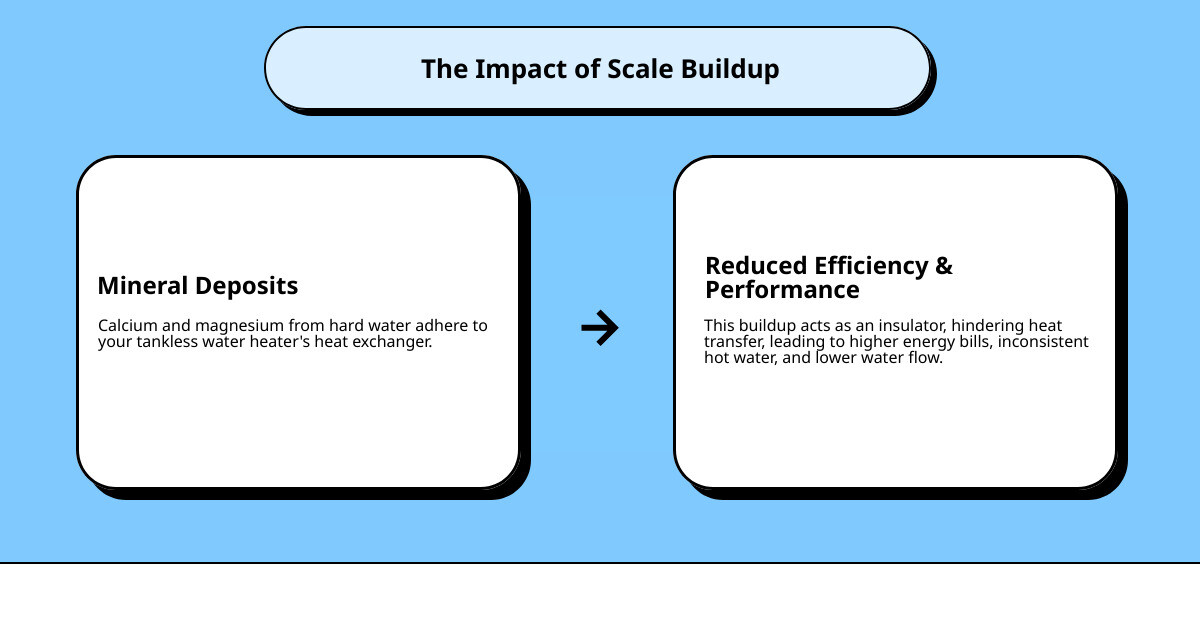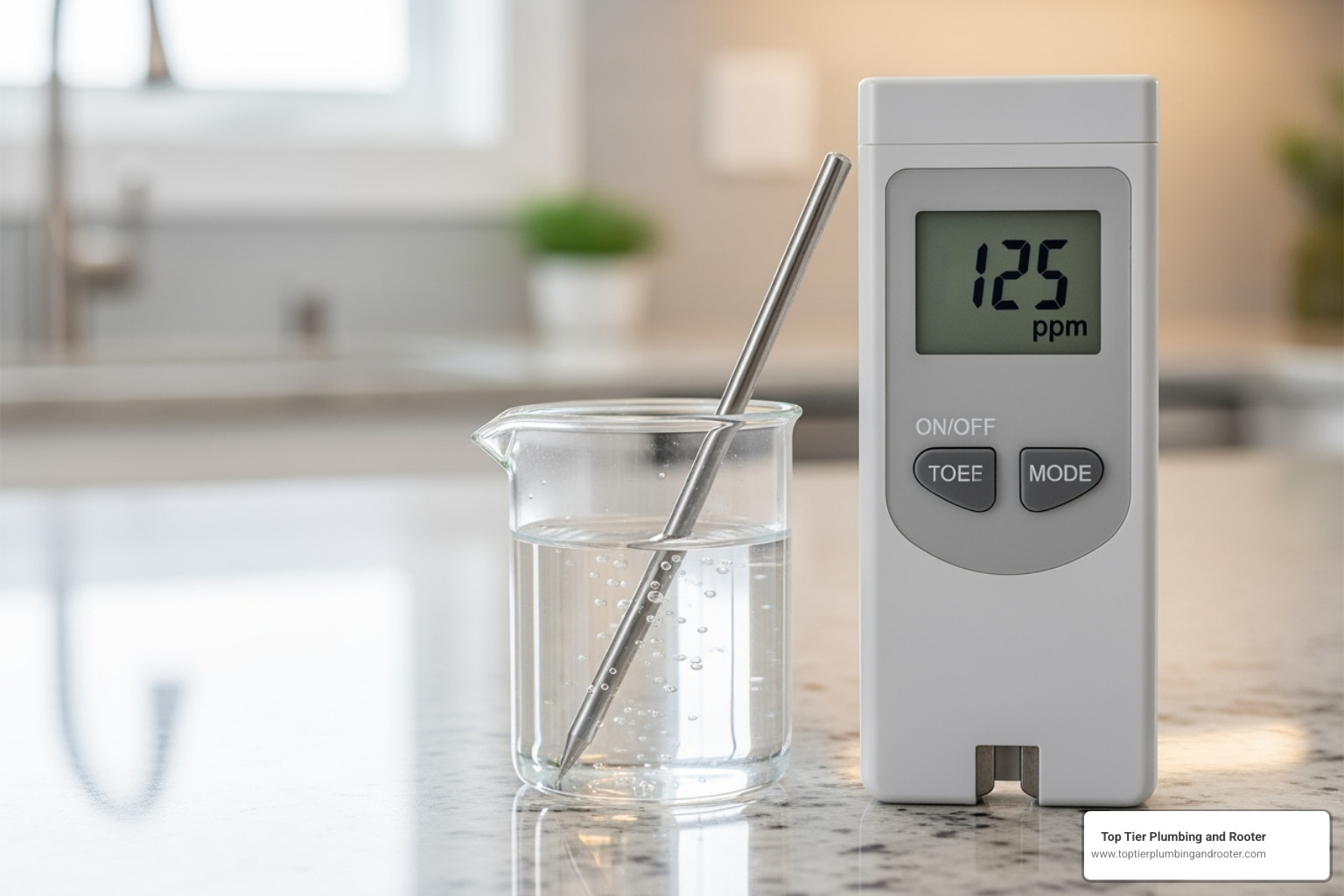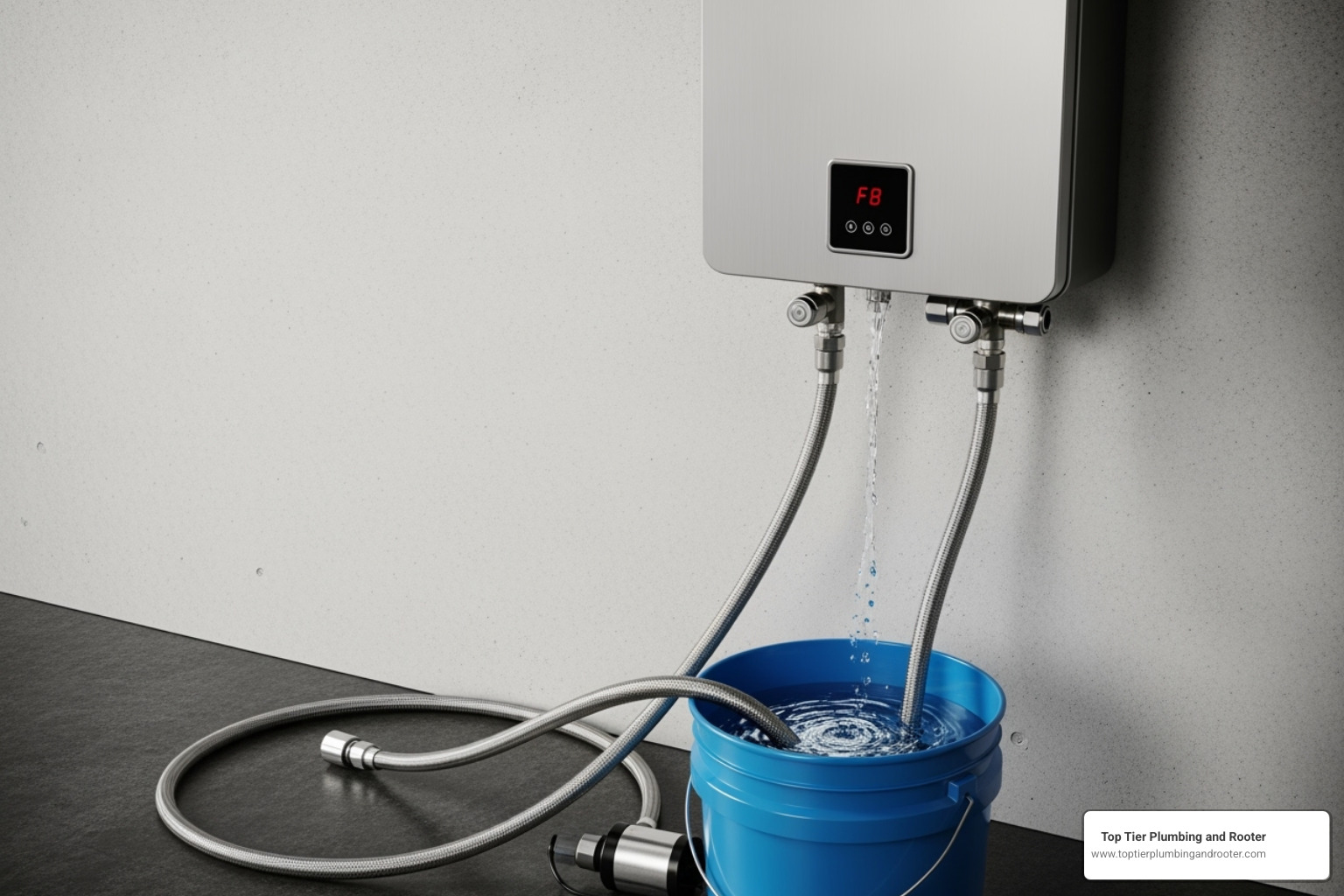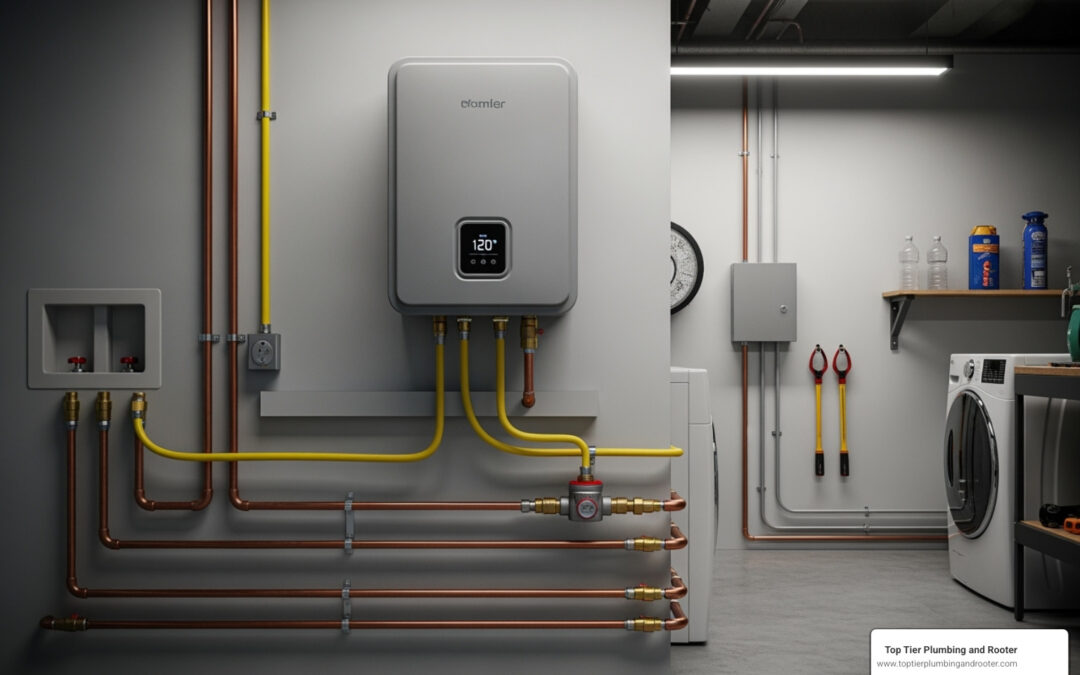Why Your Tankless Water Heater Needs Regular Descaling
Tankless water heater descaling is essential maintenance that removes mineral buildup from your unit’s heat exchanger. Your tankless heater provides endless hot water by heating it on demand, but minerals in your water—mainly calcium and magnesium—stick to the inside of the heat exchanger. This is especially true in Riverside and San Bernardino counties, where hard water is common.
These mineral deposits, known as scale, act like a thick blanket around the heating elements. Scale buildup can reduce your unit’s efficiency by up to 30%, forcing it to work harder and increasing your energy bills. Without regular descaling, you’ll notice weaker water pressure, fluctuating temperatures, and unusual noises.
The good news is that descaling is a manageable DIY task. It typically takes 1-2 hours using a commercial descaler or white vinegar. Performing this maintenance at least once a year (or every six months in hard water areas) can extend your unit’s lifespan from the typical 8-10 years to 15-20 years.

Why Descaling is Crucial for Your Tankless Water Heater
Imagine trying to brew coffee through a clogged filter—that’s what happens when scale builds up in your tankless water heater. This chalky, rock-hard buildup consists mainly of calcium and magnesium minerals. When water heats up, these minerals cling to your heat exchanger’s surfaces. In Riverside and San Bernardino counties, our hard water accelerates this process.
The heat exchanger is the heart of your tankless system. When scale coats its narrow passages, it creates a barrier that blocks heat transfer, forcing your unit to work harder. This mineral buildup actively sabotages your hot water experience in several ways:
- Reduced Efficiency: Your heater works overtime to heat water through the insulating scale, leading to higher energy consumption and bigger utility bills.
- Restricted Water Flow: As scale thickens, it clogs the heat exchanger’s pathways. You’ll notice weaker water pressure and inconsistent temperatures that make showers a game of hot-and-cold roulette.
- Component Damage: The extra strain causes the unit to overheat, wearing down expensive parts and leading to premature failure and costly repairs.
Left unchecked, scale buildup can shorten your heater’s lifespan from 15-20 years to just 8-10. Regular tankless water heater descaling stops this destructive cycle. By dissolving and flushing away mineral deposits, descaling restores efficiency, ensures consistent hot water, and protects your investment. It’s a key part of enjoying the advantages of upgrading to a tankless water heater for years to come.
When and How Often to Descale Your Unit
How often should you descale your tankless water heater? The general rule is at least once a year. However, your home’s water hardness is the biggest factor. For homes with hard water, which is common in Riverside and San Bernardino counties, you may need to perform tankless water heater descaling every six months.
The harder your water, the faster mineral deposits build up in your heat exchanger. Usage patterns also matter; a large family using lots of hot water will need to descale more often than a small household. Higher temperature settings also accelerate scale formation.

Signs of Scale Buildup
Your tankless water heater will give you signs when it needs attention. Look out for these red flags:
- Reduced water pressure: If your shower feels more like a mist, scale might be clogging the unit.
- Fluctuating water temperature: Sudden cold blasts during a hot shower often mean scale is interfering with the heat exchanger.
- Unusual noises: Popping or rumbling sounds can indicate mineral deposits are rattling around or causing uneven heating.
- Error codes: Modern units may display error codes related to flow restrictions or overheating caused by scale.
How to Test Water Hardness
To find out if you have hard water, you can use DIY test strips from a home improvement store. Simply dip a strip in your tap water and compare the color to the provided chart.
Another option is to check your local water quality reports. Riverside and San Bernardino counties publish annual reports detailing water contents, including hardness levels. These are typically available on your water provider’s website. If you use well water, a professional test is recommended as quality can vary significantly.
Understanding your water hardness is key to creating a maintenance schedule that keeps your tankless water heater running efficiently.
Your DIY Guide to Tankless Water Heater Descaling
Ready to tackle tankless water heater descaling yourself? It’s a satisfying project that can save you money and keep your hot water flowing. Before starting, always consult your owner’s manual for model-specific instructions.
Essential Tools and Materials for Tankless Water Heater Descaling
Gathering your supplies beforehand will make the process much smoother. You will need:
- A submersible utility pump (1/6 HP is usually sufficient)
- Two high-pressure hoses (washing machine hoses work well), 6-10 feet long
- A 5-gallon bucket
- Descaling solution (commercial or white vinegar)
- A wrench
- Towels
Choosing Your Descaling Solution: Commercial vs. Vinegar
You have two main options for your descaling solution. Both are effective, but they have key differences.
| Feature | Commercial Descaler | White Vinegar (Acetic Acid) |
|---|---|---|
| Effectiveness | Highly effective and fast-acting, designed specifically for mineral scale. | Effective for minor to moderate buildup. May require longer circulation for heavy scale. |
| Cost | Generally more expensive per use. | Very affordable and readily available. |
| Environmental Impact | Varies by product; some are biodegradable, others require careful disposal. | Eco-friendly, natural, and biodegradable. Safe for drains. |
| Time Required | Often works in 30-45 minutes. | May require 45-60 minutes or longer. |
| Safety | Follow manufacturer’s instructions. Some can irritate skin/eyes. | Generally safe and non-toxic. Avoid prolonged skin contact. |
For routine annual maintenance, white vinegar is a great choice. If your unit has been neglected or you suspect heavy buildup, a commercial descaler is likely worth it.
The Step-by-Step Process of Tankless Water Heater Descaling
Follow these steps for a successful descaling.
- Safety First: Turn off the power to your unit at the circuit breaker (for electric models) or shut off the gas supply (for gas models).
- Isolate the Heater: Close the hot and cold water isolation valves leading to your heater. Then, close the service valves (purge valves) and remove their caps.
- Prepare the Solution: Mix your commercial descaler according to the package directions or pour 1-2 gallons of undiluted white vinegar into your 5-gallon bucket. Ensure there’s enough liquid to keep the pump submerged.
- Connect the Hoses: Attach one hose from the pump’s outlet to the cold water service valve. Place the pump inside the bucket. Connect the second hose from the hot water service valve back to the bucket, creating a closed loop.

- Circulate the Solution: Open both service valves, plug in the pump, and let the solution circulate for 45-60 minutes. The solution may change color as it dissolves minerals. For more details, you can reference this guide on How to Descale a Tankless Water Heater.
Flushing and Finalizing the System
Flushing is a crucial final step to remove all traces of the acidic solution.
- Stop Circulation: Unplug the pump and close the cold water service valve. Disconnect the hoses and dispose of the used solution (vinegar can go down the drain; check local rules for commercial products).
- Flush with Clean Water: Refill the bucket with clean water, reconnect the pump to the cold water service valve, and open the main cold water isolation valve. Let fresh water run through the unit and out the hot water service hose for 5-10 minutes until it runs clear.
- Restore Service: Disconnect all hoses, replace the service valve caps, and open the hot and cold isolation valves. Restore power and/or gas to the unit.
- Final Check: Turn on a hot water faucet to purge any air from the lines. Check for leaks around your connections. You should notice improved performance right away.
Prevention and Professional Help
While tankless water heater descaling treats the symptoms of hard water, prevention tackles the root cause. Taking proactive steps can reduce scale buildup and extend the time between cleanings, which is especially important in Riverside and San Bernardino counties.
Preventative Measures
- Water Softener Installation: A whole-house water softener is the most effective way to combat scale. It removes calcium and magnesium before they reach your appliances, extending the life of your water heater and improving water quality throughout your home.
- Pre-filter Installation: A pre-filter on the cold water inlet line catches sediment and larger particles, protecting the internal components of your unit.
- Lower Water Temperature: Setting your heater to around 120°F can slow the rate of mineral precipitation without sacrificing comfort.
These strategies work best with regular maintenance. Learn more in our guide on Maintaining Your Tankless Water Heater: Tips for Longevity and Efficiency.
When to Call a Professional
DIY descaling is manageable for many, but sometimes calling a professional is the smarter choice. Consider hiring an expert if:
- You lack confidence or experience: Improper descaling can damage your unit or void its warranty. If you’re uncomfortable with the process, it’s best to call for help.
- You face persistent issues: If you’ve descaled the unit but still have low pressure, temperature fluctuations, or error codes, a professional can diagnose underlying problems.
- Your unit lacks service valves: Descaling is much more complex without dedicated service ports. A plumber can perform the maintenance safely.
- You’re short on time: Our team at Top Tier Plumbing and Rooter can handle the maintenance for you, ensuring it’s done correctly and efficiently.
If you’re weighing your options, our guide on Should You Replace or Repair Your Water Heater? can help you make an informed decision.
Frequently Asked Questions about Descaling
Here are answers to common questions we receive from customers in Riverside and San Bernardino counties about tankless water heater descaling.
What happens if you don’t descale your tankless water heater?
Skipping descaling allows mineral buildup to cause significant problems. You can expect:
- Reduced Efficiency and Higher Bills: Scale insulates the heat exchanger, forcing the unit to work harder and use more energy.
- Inconsistent Performance: You’ll experience fluctuating water temperatures and reduced water flow.
- Component Damage: The extra strain can cause parts to overheat and fail prematurely, leading to expensive repairs.
- Shortened Lifespan: A neglected unit may only last 8-10 years instead of the expected 15-20 years.
Can descaling damage a tankless water heater if not done correctly?
Yes, improper descaling can cause serious damage. The biggest risks include:
- Using the Wrong Solution: Harsh chemicals not designed for water heaters can corrode metal parts and damage seals.
- Improper Flushing: Leaving acidic solution in the system can eat away at the heat exchanger, leading to leaks and failure.
- Ignoring Instructions: Failing to follow the correct procedure can result in leaks, pressure issues, or other damage.
If you have any doubts, it’s always safest to hire a professional.
How can I tell if I have hard water in Riverside or San Bernardino County?
Hard water is common in our service area. Telltale signs include:
- White residue on fixtures: Chalky deposits on faucets and showerheads.
- Soap scum buildup: A cloudy film on shower doors and tubs that’s difficult to clean.
- Stiff, faded laundry: Clothes and towels may feel rough and lose their color faster.
For a precise measurement, you can use a DIY test kit or check the annual municipal water report from your local provider. Given the water quality in the region, you should plan to descale your unit at least annually.
Conclusion: Protect Your Investment with Proper Maintenance
Your tankless water heater is a smart home upgrade, delivering endless hot water and energy efficiency. To ensure it performs at its best, regular maintenance is essential. Tankless water heater descaling is the key to preventing scale buildup, extending your unit’s lifespan, and ensuring you always have consistent hot water.
Whether you follow our DIY guide or decide to call in an expert, routine descaling is the best way to protect your investment. With proper care, a tankless unit can last 15-20 years, especially in the hard water conditions of Riverside and San Bernardino counties.
At Top Tier Plumbing and Rooter, we understand that not everyone has the time or desire for DIY projects. Our expert team provides comprehensive tankless water heater services, from routine descaling to complex repairs. We are committed to quality work, upfront pricing, and 100% satisfaction.
If you need professional maintenance or have questions about your system, we’re here to help keep your hot water flowing smoothly. For professional tankless water heater services, contact our experts today!



